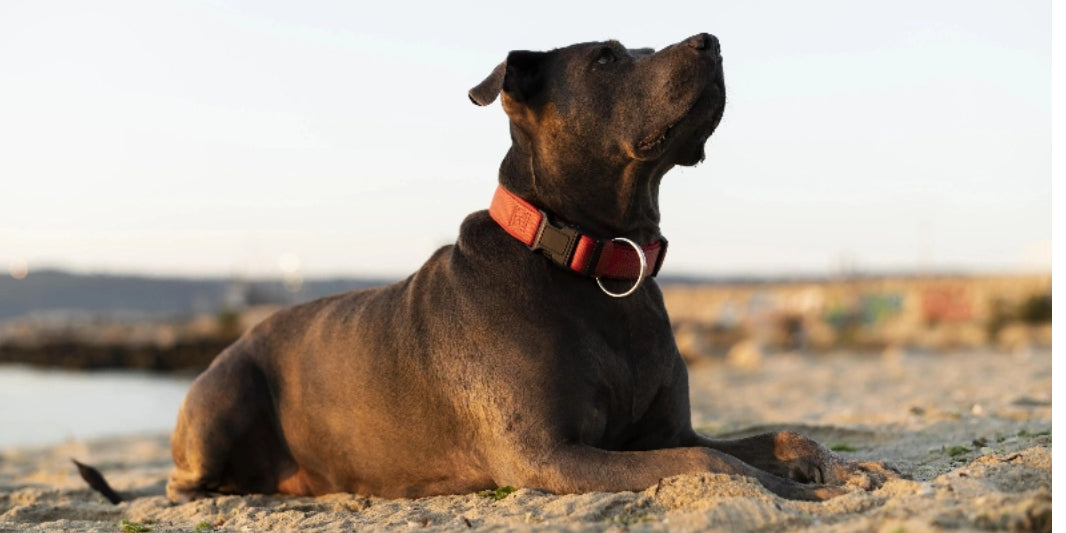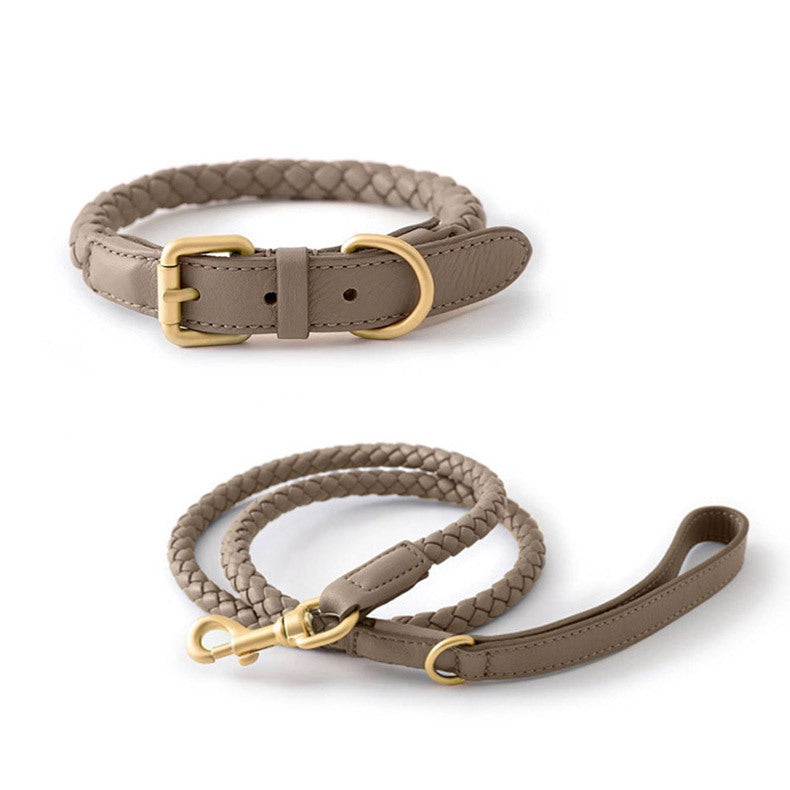
How to sew a dog collar
Share
The moment you put a dog collar on your pet, this seemingly simple strap takes on a critical protective mission – it is not only the essential connection point of the dog leash but also a lifeline for your dog’s safe travel. Today, we will delve into the significance of dog collars: from the basic safety function of preventing lost dogs, to the crucial role in dog health monitoring (judging body changes through collar fit), and its identity as a core tool for dog behavior training. High-quality collars can simultaneously address these three major dog ownership pain points. So, how to sew a DIY dog collar full of love for your beloved pet? This step-by-step guide will show you.
1. The importance of an excellent dog collar
Dog collars are essential dog walking gear for daily use. They provide critical protection both during outdoor dog activities and indoor dog safety.
First, preventing tracheal collapse is paramount. For dogs that pull on the leash or are hyperactive, the best no-pull dog collars offer neck injury prevention. Veterinarian-designed collars distribute pressure evenly, significantly reducing the risk of windpipe damage.
Second, collars enable dog collar comfort care. An adjustable dog collar with proper collar fit (maintaining the two-finger rule) prevents collar rash on dogs. Hypoallergenic collars using medical-grade silicone or organic cotton minimize skin allergies in dogs.
Third, collars prevent lost dogs through dog ID tags solutions. Per rabies tag requirements, engraved pet tags with microchip backup provide emergency pet contact. To avoid allergic reactions, prioritize non-toxic dog collars and dermatologist-tested materials that prevent collar contact dermatitis. Finally, LED dog collars or reflective strips for dogs ensure nighttime dog visibility. U.S. DOT confirms: reflective gear reduces pet accidents by 90% after dark.
2. Why Sew a DIY Dog Collar
When commercial dog collars cause allergies, neck eczema in dogs, or hair loss from collars – and custom collar costs soar – handmade dog collars transition from hobby to essential pet gear. Amid mass-produced pet products, DIY dog collars now offer pet owners worldwide a healthy dog collar solution prioritizing:
- Hypoallergenic collar materials
- Custom-fit dog collar safety
- Emotional bonding with pets
3. Advantages and disadvantages of sewing dog collars
Sewing dog collars offers benefits but has critical drawbacks. Know these DIY pet collar risks before crafting:
3.1 DIY Collar Advantages: Customization & Savings
Chemical-free dog collars: Self-selected medical-grade organic cotton/chromium-free leather avoids commercial collar allergens (APDT: 68% of pet skin allergies from industrial dyes).
Hypoallergenic solutions: Sew cotton-lined collars for sensitive dogs or velvet covers for short-haired breeds.
Perfect-fit collars: For dachshund collars/greyhound neck measurements (0.5cm error vs. 4cm in store-bought).
Cost-effective pet gear: Genuine leather collar DIY costs $8 – just 1/5 of brands (Source: LeatherCraft Magazine).
3.2 DIY Collar Dangers: Strength & Toxicity Risks
Collar breakage hazard: Household thread has ≤50kg tensile strength (JIS L1096) vs. 90kg impact force from dog pulling (FDA: 300% break risk ↑).
Toxic dog accessories: Self-bought D-rings zinc (35% over limit) cause chronic poisoning in dogs (2023 US CPSC recall).
Time-cost paradox: Takes 2-8 hours/collar vs. 5-30 mins buying. Requires 15+ hours of collar sewing practice.
Key Conclusions: Safe DIY Collar Scenarios
- Only recommended for:Small dog collars (<5kg), Decorative collars, Emergency collar repair.
- Contraindicated for:Medium/large breed collars, Aggressive dog collars, Rainy environments (87% mold risk in untreated leather).
- Safety essentials:Aviation aluminum buckles, Industrial-grade polyester thread (Tex 70),3:1 weight-bearing test.
4. Material selection for sewing dog collars
4.1 Leather Dog Collars
Leather Collar Advantages
- Natural durability: Top-grain cowhide offers ≥70kg tensile strength (ASTM D2209), retaining 85% strength after 3 years.
- Breathable dog collars: Porous structure reduces neck heat rash by 37% (ideal for long-haired breeds).
- Safety break-in: Softer over time, preventing sudden collar failure.
Leather Collar Disadvantages
- Water damage risk: 50% flexibility loss after 3 rain exposures.
- High-cost pet gear: Vegetable-tanned leather costs $15/ft – 6x nylon collar price.
- Collar maintenance routine: Requires monthly mink oil treatment to prevent leather cracking.
4.2 Nylon Dog Collars
Nylon Collar Advantages
- Extreme strength: Heavy-duty nylon webbing offers 200kg tensile strength – 6x dog’s weight capacity.
- Waterproof dog collars: Maintains integrity after 72hr + bleach-safe cleaning (84 disinfectant compatible).
- Lightweight pet gear: Just 1/3 leather collar weight (reduces neck strain in large dogs by 40%).
4.3 Microfiber Leather Dog Collars
Synthetic Collar Advantages
- Balanced durability: 90kg tensile strength + waterproof coating (passed 72hr rain simulation test).
- Easy-clean dog collars: Stain removal with damp cloth (87% lower collar maintenance cost vs leather).
- Color stability: Color difference ≤3 grades after 500 hours of UV irradiation (ISO 105-B02 standard).
Synthetic Collar Disadvantage
- Relatively poor air permeability: The air permeability in a humid and hot environment is not as good as that of leather.
- Fragile stitching: Due to material reasons, if the industrial manufacturing technology is not mature, the pinhole is prone to cracking when repeatedly bent.
4.4 Organic Cotton Dog Collars
Cotton Collar Benefits
- Hypoallergenic safety: USDA-certified organic cotton offers 0% allergy rate in dogs.
- Eco-friendly pet gear: Biodegrades naturally within a 180-day decomposition period.
- Adjustable comfort: Knot-adjustable design accommodates daily neck size changes.
Cotton Collar Limitations
- Wet strength failure: 50% tensile strength loss when wet (critical threshold: 30kg).
- Bacterial growth risk: Rapid colony multiplication in damp collar environments.
5. Essential tools for sewing dog collars
5.1 Basic sewing tools
- Heavy-duty sewing machine
- Professional stitches and needles
- Safety accessories system
5.2 Fasteners and connectors
- D buckle: Made of aviation aluminum (tensile strength ≥800lbs), zinc alloy is prohibited (risk of zinc poisoning).
- Buckle: For nylon material, a stainless steel core is required (to prevent canine teeth from biting through).
- Certification standard: It is best to comply with CPSC certification.
- Reflective strip: 3M™ Scotchlite (Reflective intensity ≥330cd/lx/m²).
- Sewing requirements: Fold the edge inward by 1cm and sew it in to avoid thread wear.
5.3 Precise measurement and cutting
Laser scale: Error ≤0.1mm (neck circumference +6cm for measurement).
Hot cutting knife (nylon/microfiber) : Quick edge sealing with propane spray gun (temperature 300℃/ distance 15cm).
Leather cutting knife: Japanese OLFA rotary knife (uniform thinning to 1.2mm)
Edge processing consumables.
Edge banding liquid: Fiebing's resin-based (Anti-cracking for genuine leather).
Heat-sealing rubber strip: Special for nylon webbing (melting point 120℃)
Reinforcement and quality inspection equipment.
5.4 Stress Point Strengthening Tools
Riveting gun: Equipped with copper rivets (spacing ≤2cm).
Leather pad: 0.8mm vegetable-tanned leather (placed on the contact surface of the D buckle to prevent wear and tear).
5.5 Protective and Auxiliary Equipment
Personal protection
Cut-resistant gloves: Level 5 cut-resistant grade (DuPont Kevlar material).
Goggles: Splash-proof design (Essential for handling metal parts.
Templates and locators
Adjustable paper scale: including dog breed neck circumference data (Golden Retriever standard 38-42cm, etc.).
Hole positioner: Ensure that the error of the latch hole distance is ≤1mm.
6. The specific steps for sewing a dog collar
6.1 Attach Fixed Buckle and D-ring
Pass one end of the webbing strap through the horizontal bar of the interlocking female buckle. Fold back approximately 3-4cm against the strap's backside and secure temporarily with a pin.
Position the D-ring (opening facing inward) vertically at the center of the folded section, aligned with the double-layered webbing overlap.
Stitch a reinforced box stitch (minimum 2 passes) across the webbing's width using heavy-duty thread (e.g., nylon/polyester). Ensure stitching penetrates all webbing layers and anchors the D-ring's base. Securely knot and conceal thread ends.
6.2 Construct Collar Body
Measure the dog’s neck circumference, adding 8-10cm adjustable length at the strap’s opposite end.
Thread the free end sequentially through:
- Top slot of the male buckle
- Top slot of the V-shaped buckle (D-ring side)
Fold back the webbing and thread downward through the V-shaped buckle’s lower slot.
Tighten until the male buckle seats flush against the V-shaped buckle. Stitch two parallel reinforced seams (≈0.3cm apart) along the folded edge. Use fine stitches (3-4 per cm), ensuring seams secure the male buckle’s bar wrap area.
6.3 Reinforcement and Finishing
Sew X-shaped reinforcement stitches at both sides of the V-shaped buckle to prevent strap slippage.
Trim excess threads. Flame-seal nylon webbing cuts with a lighter to prevent fraying.
Test functionality,Adjust tightness via the V-shaped buckle, verify smooth buckle operation, and confirm D-ring stability under tension.
The safety hazards of hand-stitched dog collars demand serious attention. While crafting a collar for your beloved pet demonstrates thoughtful care, homemade collars carry significant safety risks that endanger canine safety. Hand-sewn connection points (D-rings, buckles) lack guaranteed stitch strength,during leash pressure or sudden lunging, sewing thread failure causes instant collar detachment—creating high escape risks and potential traffic accidents.
Suboptimal material selection (insufficient webbing abrasion resistance, inadequate buckle strength) or flawed sewing techniques (excessive stitch spacing, insufficient reinforcement) accelerates wear at critical failure points. These uncontrollable factors make DIY collars vulnerable components in pet safety systems.
7. The best-selling collar product in summer
7.1 AirTag Dog Collar Leather Suede
Secure your dog's safety and comfort with the Airtog exclusive leather tracking collar, ensuring it never goes offline!
Worried about your dog getting lost by accident? Longing for a collar that is both durable and tasteful? The Airtog double-layer reinforced leather tracking collar is your reliable choice!
- The outer ring is made of carefully selected leather, while the inner ring is made of high-strength nylon.
- Precise adjustable design, perfectly fitting the neck circumference.
- Super strong tensile and wear-resistant, durable and reliable.
- Designed specifically for Airtog tracking, anti-loss for greater peace of mind.
No longer let getting lost be a hidden danger! Choose the Airtog leather double-layer reinforced collar to ensure the safety and freedom of your furry friends with its outstanding quality. Get it right now and give it the most reliable protection!
7.2 Braided PU Cotton Dog Collar
Bid farewell to the trouble of sudden surges and experience gentle protection! The dog collar is hand-woven with natural cotton rope, making every walk relaxing and comfortable.
Still worried about your dog suddenly charging and pulling? Worried that the collar might hurt your furry friend's delicate neck? This Braided PU & Cotton hand-woven collar uses natural forces to mitigate impacts, providing you and your dog with a more comfortable and reassuring walking experience!
- Crafted by hand with meticulous care, the cotton rope is flexible and skin-friendly.
- Unique weaving structure, intelligent buffering and explosion-proof impact.
- The PU leather buckle adds the finishing touch, which is firm, durable and easy to adjust.
- Breathable, refreshing and easy to maintain.
Choose the temperature of handcrafting to endow safety with power. Give the lively and active it a gentle restraint, and let every trip become a pleasant companion. Dress your beloved dog in a Braided cotton rope collar, bid farewell to the anxiety of running around, and enjoy a leisurely dog walk!
7.3 Woven leather dog collar
When classic leather craftsmanship meets exquisite technology, it weaves a solid and protective fabric! Woven Leather Explosion-proof collar, giving your dog a sense of security at ease.
Tired of the momentary tugging and potential risks brought by a dog's sudden dash? Longing for a collar that combines elegant texture with reliable protection? This Woven Leather hand-woven dog collar creates extraordinary cushioning performance with unique craftsmanship, making dog walking elegant and reassuring from now on!
- Hand-woven genuine leather, classic and comfortable together.
- The machine has been reinforced twice, providing double locking strength and toughness.
- Intelligent woven structure, efficient buffering and explosion-proof impact.
- Secure hardware, convenient adjustment.
It's not just about elegance, but more about protection. Woven Leather collar, providing a gentle yet powerful cushioning barrier for lively pets with exquisite craftsmanship. Say goodbye to the thrilling rush and enjoy every confident and composed journey together!
Conclusion
Professional dog collars offer superior safety assurance for responsible pet owners. Certified factory-manufactured collars utilize high-strength tear-resistant materials (aviation-grade nylon, reinforced polyester webbing) and undergo rigorous strength testing (static tension, dynamic impact resistance). Key load-bearing components feature industrial-grade metal hardware (buckles, D-rings) secured via reinforcement technologies (high-frequency welding, riveting, multi-layer stitching) for unbreakable connections.
Professional collar designs ensure secure adjustability with canine-specific ergonomics to prevent accidental loosening often backed by third-party safety certifications. Entrusting your dog’s protection to scientifically validated professional products remains the wisest choice to prevent escape, strangulation hazards, and deliver maximum safety.








